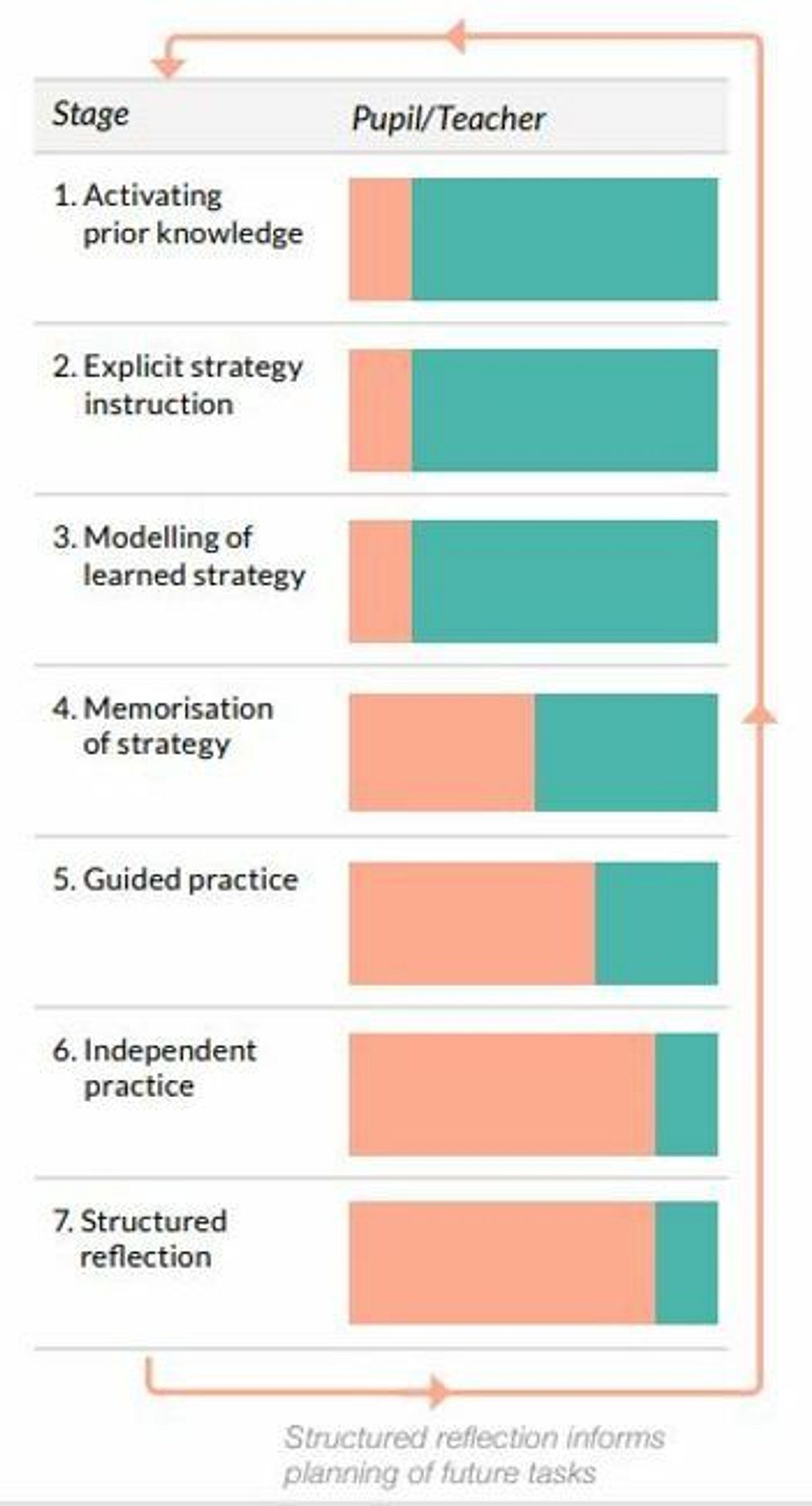Reading fluency is often described as a bridge between word recognition and comprehension. Some pupils may be able to cross the bridge independently if they regularly read varied and appropriately challenging texts. However, this crossing is a difficult journey for those who don’t.
Strategies such as Reader’s Theatre mirror the ‘gradual release of responsibility’ model that is exemplified in EEF ‘Metacognition and Self-regulated Learning’ guidance report, helping struggling readers to reach independence in a supportive, intentional way:

Teaching reading fluency with the Seven-step model
Stage 1: Activating prior knowledge
This is a short and sharp part of the lesson designed to ‘set the scene’ for the fluency practice. One favourite strategy is to ask quick ‘show me’ questions using mini-whiteboards to recall the most important information from the previous chapter. Another is to write post-it note summaries of each chapter of our class novel to keep on a cumulative summary display. This way, lessons can begin with a rapid recap of ‘the story so far’.
In my experience, a little and often approach to teaching the strategy of summarising is more beneficial than attempting to teach it as a discrete skill.
Stages 2 – 3: Explicit strategy instruction and modelling of learned strategy
Following the activation of prior knowledge, the teacher then reads the text aloud, modelling expert prosody. A passage will have been chosen for pupils to practise their own fluent reading.
Choosing the right text or extract here is key. It should be challenging enough that the pupils wouldn’t comfortably decode it independently, but a level of difficulty that’s attainable with teacher modelling and scaffolding.
In my school, we use the term ‘performance reading’ to refer to a prosodic, meaning-laden style of reading. We regularly share the importance of practising this to train pupils to develop their own ‘performance reading voice’.
Performance reading in my school is comprised of the 6 P’s:
- pace
- pitch
- pauses
- punctuation
- personality
- power
At this stage of the lesson, the teacher might ‘cue the pupils in’ to what they should listen for (“I’m going to read a part of the story now where the characters are going into a scary new setting — pay special attention to the way I use pace and pauses to create tension”).
The teacher can then model reading aloud in a way that best illuminates the meaning of the text. This might involve a slightly slower than natural prosody, or giving extra emphasis to certain words or phrases, so pupils’ attention is drawn to salient parts of the text.
Stages 4 – 5: Memorisation of strategy and guided practice
What happens at this phase will vary depending on the age and experience of the pupils. At the simplest level, it might involve asking pupils ‘what did you notice?’ or ‘what happened to my reading when…?’ It may involve using echo reading to practise certain sentences or paragraphs.
With pupils who have had plenty of practice of performance reading, we might complete some text marking, annotating the text using an agreed code to show where extra emphasis is placed, to show rising or falling pitch, or to ‘scoop’ words and phrases into clause or sentence units. This marked-up version of the text then acts as a guide for their own practice.
Stages 6 – 7: Independent practice and structured reflection
Pupils should now be ready for the challenge of decoding the text independently and with increasing fluency. They do this with a response partner: one pupil reads the text while the other listens and follows with a ruler. At the end of the extract, the listener offers feedback about what went well and what might be improved next time before the pupils swap roles.
The teacher’s role at this stage will vary. In the early stages of implementing fluency practice, they will need to ‘be seen listening’, walking the room to listen and ensure that agreed routines are being stuck to. As the pupils become more familiar with routines, the teacher’s role can transition more to guiding practice and supporting pupils who might find reading difficult.
Pupils should be given time to practise their extract multiple times, aiming for greater fluency each time with the support of their partner. Partners should offer feedback on challenging words and phrases, using the language of the 6 Ps.
Research evidence indicates the promise of a focus on reading fluency, so these practical approaches, translated to the classroom can go a long way towards helping a greater number of pupils to ‘cross the bridge’ to become accomplished readers.
Seven step model
The ‘Seven-step model’ offers a useful framework to support teachers in developing their pupils’ independence.Uploaded: • 437.4 KB - pdfSeven step model worksheet
Planning tool to help practitioners explicitly plan how to approach deliberately shifting the responsibility from themselves to the pupil.Uploaded: • 343.1 KB - pdf
Blog
Why focus on reading fluency?


Blog
EEF blog: Bridging literacy transition with fluency
